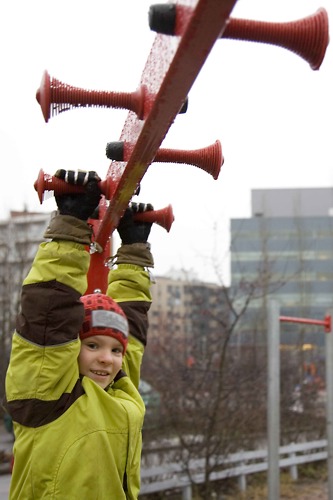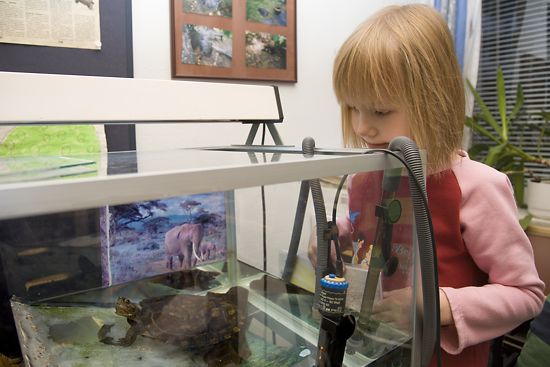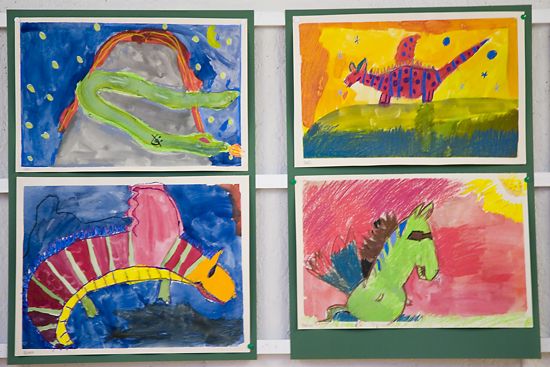Do Schools In Finland Decorate Their Classrooms?
All Finnish kids address their teachers by their first names, as the students at Helsinki'southward Strömberg School do, only many other aspects of education at this schoolhouse tin can be considered progressive no thing where you're from. Allow's open up the door and step inside.
Here we become!
Information technology's a few minutes past eight and the dim October morn has not yet given way to daylight when the pupils of Strömberg Lower Comprehensive School (ages 7–13) beginning taking off their jackets, caps and shoes in front of their coat-racks. An inviting burn down, lit by the school caretaker to cheer the pupils upwardly, is crackling in the fireplace in the hall.
Hellos are shouted along the corridors equally pupils, teachers and the residuum of the school staff greet each other. In this school, everybody knows each other, and the pupils phone call their teachers past their first names, as is customary in Finland.
Each kid finds his or her own group. The classes are named after animals that live in Finnish forests: Elks, Bears, Foxes, Lynx, Hawks, Weasels, Seals, Eagle Owls and Wolves. And there are the Beavers, a class of pupils with mental disabilities; these kids arrive by taxi each morn. The schoolhouse day tin brainstorm.
Light, space and social spectrum

Students at Strömberg Lower Comprehensive School and schools everywhere in Republic of finland spend time outside during recess, no matter what the weather condition.Photograph: Anna Dammert
Strömberg Lower Comprehensive School in Pitäjänmäki, a suburb of Helsinki, is located in the middle of an sometime industrial estate that has recently been filled with new blocks of flats. Situated near busy thoroughfares in the western office of Helsinki, some ten kilometres from the middle, Pitäjänmäki encompasses a wide social spectrum, from high-income homeowners to low-income families living in city-endemic rental houses. A fair number of immigrants live in the surface area.
The school itself is a City of Helsinki comprehensive school, drawing pupils from homes in the neighbourhood. It is located in a former automobile engineering workshop that was converted and extended for use every bit a school in 2000. The school master, Päivi Ristolainen, took part in planning both the school curriculum and the building, her expertise helping ensure that they serve the modern concept of good learning.
In typical Nordic architectural way, the bounds are low-cal and spacious, the materials durable and the colours warm. Apart from ordinary classrooms, the school has workshops for magazine-making, handicrafts, music, drama, science and ecology education; and a gym and a library. The school'south specialities include a small wintertime garden, corners with sofas for reading, and chess tables for games.
Agile lessons
Back to the classrooms: some of the groups are existence taught in their ain home classrooms. For these lessons, which include Finnish, mathematics and more, the pupils decide weekly targets with their teachers and choose tasks to be carried out at their ain step.
Some groups are taking their turn in the workshops, learning through practical training. For instance, each group regularly spends time in the magazine workshop, working on their ain publication.
The lessons are by no means spent in silent memorization; the children walk around, gather data, ask communication from their teacher, cooperate with other pupils and occasionally even residuum on the sofa. The classroom situation is active, simply the teacher never lets go of the reins – and doesn't have to resort to authoritarian methods.
Learning by doing

Students at the Strömberg Schoolhouse have turns taking care of the pet tortoise, Pertsa.Photo: Anna Dammert
Each lesson lasts 90 minutes. The pupils normally spend the xxx-infinitesimal recess outside playing in the schoolyard, regardless of the atmospheric condition. They apply the sports field for football game in the summer and skating in the winter.
The schoolhouse follows the pedagogical principles of the Frenchman Célestin Freinet, who underlines learning past doing and customs orientation. Mrs Ristolainen-Husu points out that both the Finnish national core curriculum and the Helsinki city curriculum comply with Freinet'southward ideas, only Strömberg School takes the model 1 pace farther.
This also means that the school has historic period-grouping–integrated classes, then that each group has children of two different ages. In such groups, differences between the children are taken for granted and less comparison results.
Windows on the world
Learning by carrying out "chores" is a key chemical element in the school'southward curriculum. This means that pupils participate in common chores from the first year onwards. Taking turns in groups, they see to the schoolhouse'south houseplants, library, wastepaper drove, recycling, compost, yard and aquarium. They help in the kitchen and the Beaver classroom and care for the environmental workshop'south pet tortoise Pertsa.
Non-teaching staff guide the kids in these chores: cleaners, kitchen workers, the caretaker, the school secretary and attendants. Everyone shares responsibility for educating the children and unnecessary hierarchy is avoided amidst the staff.
The school is besides open to the local community. Parents are always welcome in the classrooms and their expertise is utilised in the workshops and evening school sessions. The classes go on a lot of excursions.
Each year the school has a special theme for all pupils; it is discussed from interdisciplinary and artistic viewpoints. The themes rotate from year to yr: water, earth, air and fire.
Lunchtime!
It'southward time for a break after all that studying. And we're hungry, likewise!
Like all Finnish schools, Strömberg School serves a costless hot meal every 24-hour interval. Today it'southward meatballs and mashed potatoes, a favourite with generations of children, served with salad, breadstuff and milk. Special portions accept been reserved for children with different dietary requirements for health or religious reasons. The children eat at cosy tables with tablecloths and flowers in vases throughout the twelvemonth.
No extra funds to a higher place the average school construction budget were spent in building or maintaining Strömberg School. Notwithstanding a lot of ideas have been implemented here that people come from all over Finland and the world to learn about. Architects, too, come up from all over the earth to see the school building designed past Kari Järvinen and Merja Nieminen.
Fun for everyone

Creative viewpoints also form part of the school mean solar day.Photo: Anna Dammert
The school twenty-four hour period is over between 12 apex and 2 pm, depending on the day and grouping. Well-nigh all the children come from families where both parents work fulltime, as is customary in Finland, and the little schoolchildren detect the afternoon alone at home too long. Consequently, city authorities have built a playground almost the school, with admission safe from motor traffic.
The playground offers the schoolchildren an extensive recreational surface area with playground and games equipment and two buildings where first- and 2d-form children tin do their homework or play indoor games. Playground attendants take care of the children, who are also provided with a snack at cost in the afternoon. Otherwise the entire playground facility is free of accuse.
After 4 o'clock in the afternoon, the playground gate opens and shuts repeatedly every bit parents arrive to pick up their children. The knees of the children'south trousers are muddied and their gloves are damp; they've washed and seen a lot. They've played hard and a fun time has been had by all.
The school as well arranges a depression-cost snack and free afternoon clubs and hobby groups for students in the upper grades. This year they are studying Japanese, learning to play in a band and doing arts and crafts.
On with your rucksacks and moving ridge to the attendants – run into you tomorrow!
By Salla Korpela, updated March 2011
Source: https://finland.fi/life-society/a-day-in-the-life-of-stromberg-school/
Posted by: lestercoubled.blogspot.com

0 Response to "Do Schools In Finland Decorate Their Classrooms?"
Post a Comment